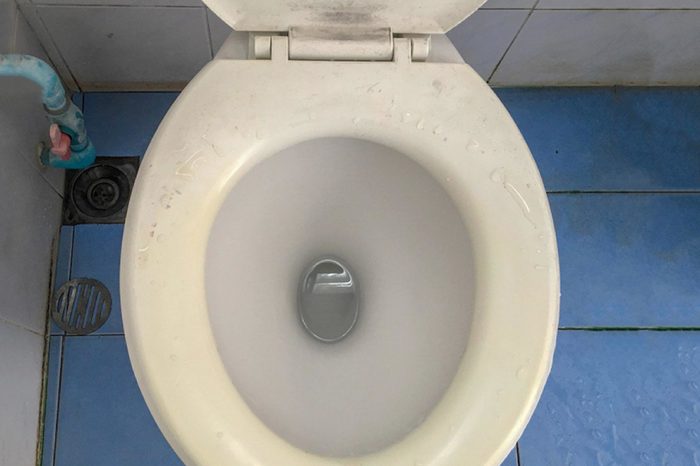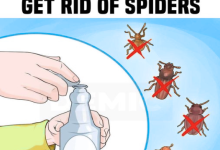Keep the germs at bay, and your home safe, by routinely disinfecting these dirtiest places in your home.
Kitchen Sink
When you leave dirty dishes in the sink, you’re creating a perfect petri dish for bacteria, which breed in damp, warm places. Even when you’re careful about rinsing dishes and loading them immediately into the dishwasher, food particles are left behind in the sink, aiding and abetting the formation of illness-causing bacteria which could include E. coli, campylobacter, and salmonella. Clean and sanitize your sink every other day by scrubbing off deposits, then filling it up with water and adding a little bleach for a five-minute soak.

Door Handles
Door handles get touched by everyone coming and going in the home, making them the Grand Central Station of bacteria. Even though door handles seem dry and innocuous, they can still support live bacteria for up to 24 hours. You can disinfect door handles with antibacterial wipes, but an easier way to reduce contagion is to use handles made from copper or its alloys, bronze, and brass. They’re naturally antimicrobial and can kill pathogens quickly, often within two hours.

TV Remote
It gets handled daily, but does your remote control ever get cleaned? Probably not, if you’re like most people. Like other objects frequently touched by human hands, TV remotes are crawling with germs and viruses. To clean your remote, remove the batteries, then wipe it down with a moist (but not drippy) antibacterial wipe. Use an alcohol-dipped cotton swab to clean the edges of the buttons.

Coffee Maker
Most people never think about their coffee maker until they need caffeine. But this continual neglect makes a coffee maker one of the dirtiest places in a home. The dark, damp recesses of its reservoir are a perfect breeding ground for germs. So every month, run your coffeepot and filter basket through the dishwasher for a sanitary cleaning. Then put four cups of vinegar in the reservoir and run a brew cycle without a filter. When finished, flush the coffee maker with four cycles of clean water.

Kitchen Sponge
You’re not wiping kitchen counters with an old sponge, are you? A kitchen sponge is one of the dirtiest places in your home. Just one square inch can contain 54 billion bacteria cells—about the same density of germs found in feces. Yuck! Running it through a dishwasher doesn’t help much. The best way to decontaminate a sponge is to microwave it at full power for two minutes, which will kill 99 percent of germs and spores. Eventually, everybody’s microwave gets a little crusty.

Carpeting
Did you know bacteria and viruses—including the norovirus, which causes stomach flu—can survive on carpeting for a month or more? That’s nasty enough, but carpeting also collects dead skin, dust mites, mold spores and other allergens. To keep contaminants at bay, vacuum at least weekly, and get your carpets professionally cleaned every six months or annually.

Dog Bed
While your dog is frolicking at the dog park or in your yard, he’s tracking through some nasty stuff you really don’t want in your house. And yet, you can bet you’ve been living with it. Dog beds can be infested not only by bacteria from trace amounts of feces on your dog’s pads, but also from parasites, such as ringworm, hookworm, roundworm, and fleas. Make sure you wash the bedding frequently and that your dog receives flea and tick preventatives.

Cutting Board
Maybe you switched to plastic cutting boards because you thought they would be more hygienic than wood. Think again. A smooth plastic cutting board is quickly marred with use, resulting in a rougher surface where bacteria can remain even after cleaning. And, it turns out that wood—particularly oak and pine—has natural antibacterial and antimicrobial properties.

Shoes
Let’s face it—we never know what we’re stepping in, which makes shoes one of the dirtiest places in the home. Recently, a microbiologist tested a brand new pair of shoes and learned that they’d collected 440,000 bacteria within just two weeks’ wear. The inside of our shoes isn’t much better. Dark and often damp, a shoe’s interior can breed bacteria and fungi, resulting not only in stinky feet but also warts and toenail fungus.

Toothbrush
Could your toothbrush be one of the dirtiest places in your home? Grab a measuring tape and see how far it is from your toothbrush to your toilet. If it’s less than six feet, your toothbrush could be covered with tiny particles of feces, which were sent airborne by the force of the toilet flushing. Even if your toothbrush is stowed safely out of range, its damp bristles likely teem with millions of bacteria. You can disinfect your toothbrush by soaking it in antibacterial mouthwash and rinsing thoroughly before using it again. And don’t forget to close the toilet lid before flushing.

Makeup
Chances are, your makeup isn’t high on your list for routine cleaning, but it should be. Like anything that gets handled frequently, makeup can collect bacteria. Most of the germs on makeup are harmless flora naturally found on your skin. But makeup can also harbor pathogens, including E.coli and staphylococcus. If applied over broken skin, dirty makeup can cause irritations, acne, and infections.
Shower Curtain
Bacteria love a steamy bathroom, which is why they glom onto shower curtains by the millions. That’s what makes your shower curtain, particularly the liner, one of your home’s dirtiest places. Your bath buddies include not only germs but mildew, which you’ll recognize right away as the black crud creeping into caulk and grout and starting to take over the bottom of your shower curtain. Fabric liners and shower curtains can be machine washed with a little color-safe bleach to kill mold and germs. (Just don’t put them in the dryer.) Or, since liners are fairly inexpensive, you could just toss yours if the contaminants are out of control. When you replace it, look for a liner that’s antibacterial and mildew-resistant.

Dish Towels
A recent study found that 89 percent of kitchen rags were contaminated with coliform bacteria, and 25 percent carried E. coli. Experts recommend washing kitchen towels after every use and using paper towels to dry your hands.
Bathmat
No shocker here. Your bathroom floors are the dirtiest ones in your house, which puts your bathmats at ground zero for germs. When neglected, they can accumulate bacteria, mildew, viruses, and fungi, which are all bad news if you happen to have a small wound on your foot. Make sure the bathmats you choose for your home are washable (no rubber backing), then run them through a sanitizing cycle every couple of weeks. Your bathroom floor will feel a lot cozier when it’s warm.

Toilet Bowl
This should surprise no one. Your toilet bowl teems with germs—about 3.2 million bacteria per square inch. And when you flush, the turbulence spews tiny particles of water-borne feces into the air in a noxious blast called an aerosol plume, which can rise as high as 15 feet. Modern low-flow toilets have reduced this effect somewhat, but to keep your bathroom cleaner, just close the lid on your toilet before you flush. Soft-close toilet seats can be closed with only a nudge, which means less handling.

Purse
When was the last time you disinfected your handbag? Never? That’s what makes a purse one of the dirtiest places in your home. A handbag gets set down everywhere, including on public restroom floors, and is rarely cleaned. Shockingly, the levels of bacteria found on a purse rival that in a toilet. In fact, one in five handbags harbors enough bacteria to be considered a health risk, with handles being the dirtiest part. So, empty your purse periodically and clean the inside and handle with an antibacterial wipe. Also clean lipstick, sunglasses, keys and everything else that’s typically kept inside.







